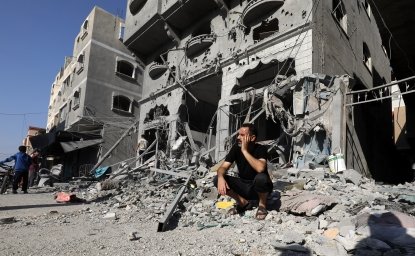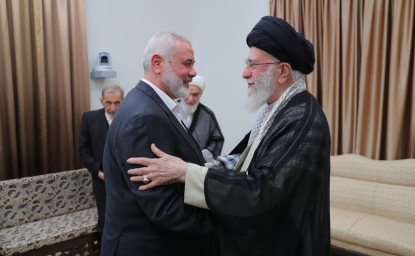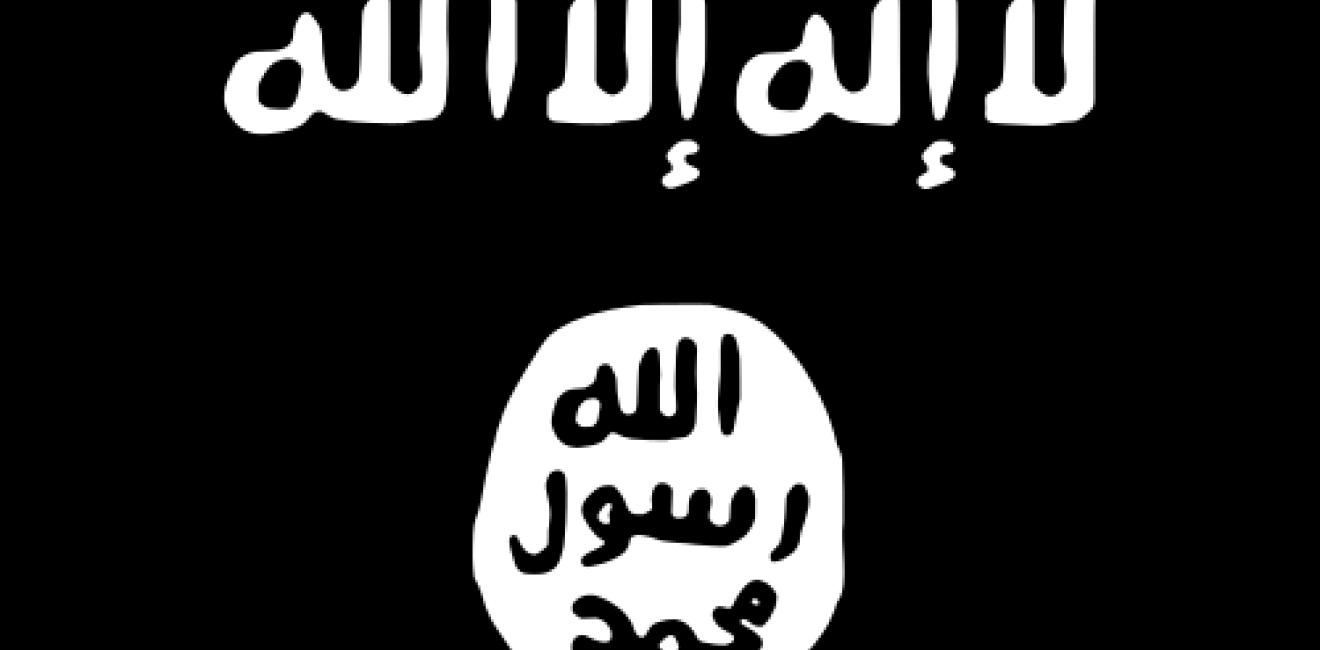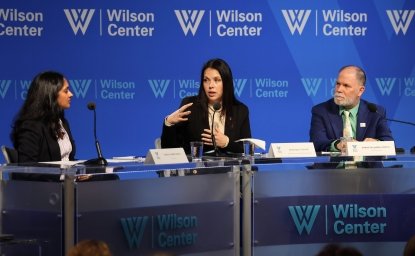The Islamic State has begun to re-establish itself in Iraq and Syria, according to a report submitted to the U.N. Security Council on January 20. The group, also known as ISIS or ISIL, has been “mounting increasingly bold insurgent attacks, calling and planning for the breakout of ISIL fighters in detention facilities and exploiting weaknesses in the security environment of both countries,” according to the U.N. monitoring team charged with tracking global terrorist groups. The group has remained resilient and well-funded, with an estimated $100 million in reserves, despite the death of leader Abu Bakr al Baghdadi during a U.S. raid in October 2019.
The United Nations said that the group’s strategy and priorities were unlikely to change under Baghdadi’s appointed successor, Amir Muhammad Said Abdal Rahman al Mawla, who is also known as Abu Ibrahim al Hashimi al Quraishi. The report suggested that Quraishi may only be a temporary “emir” due to his alleged Turkmen, as opposed to Arab, ethnicity. A legitimate caliph must come from a descendant of the Quraysh Hashemite tribe, according to ISIS’s interpretation of Islamic law. But experts warned that Quraishi’s background and ethnicity were unclear.
Twenty-fifth report of the Analytical Support and Sanctions Monitoring Team
Summary
Islamic State in Iraq and the Levant (ISIL), following its loss of territory, has begun to reassert itself in both the Syrian Arab Republic and Iraq, mounting increasingly bold insurgent attacks, calling and planning for the breakout of ISIL fighters in detention facilities and exploiting weaknesses in the security environment of both countries.
ISIL was forced into a change of leadership with the death of Abu Bakr al-Baghdadi. It is unclear whether Baghdadi’s named successor, Abu Ibrahim al Hashimi al-Qurashi, will emerge as an effective organizing force, capable of leading what has become a far-flung, diverse group of supporters and affiliates. The current assessment is that the strategic direction of ISIL with regard to administration, propaganda and recruitment is unchanged, and that command and control between the ISIL core in the conflict zone and affiliates abroad will be maintained.
The reduction of forces of the United States of America has raised concerns among Member States regarding the ability of security forces currently active in the north-east of the Syrian Arab Republic to maintain adequate control over a restive population of detained ISIL fighters, as well as family members, numbering more than 100,000. Many dependants remain equally ideologically committed and their fate is a major concern for the international community. Some 2,000 foreign terrorist fighters remain in detention in the area.
Idlib Province, in the north-west of the Syrian Arab Republic, remains dominated by groups affiliated with Al-Qaida but also plays host to relocated ISIL fighters and dependants. Parts of Iraq, especially the area of Anbar Province bordering the Syrian Arab Republic, also represent a permissive security environment for the movement of ISIL fighters.
Beyond the ISIL core conflict zone, threats from Al-Qaida and ISIL affiliates persist globally, especially in Afghanistan and its immediate neighbourhood but also in parts of Africa and South-East Asia. In West Africa, the combined efforts of the affiliates are threatening the stability of fragile Member States in the region. In East Africa, Al-Qaida affiliate Al-Shabaab maintains a steady pace of attacks on security forces and foreign targets. ISIL affiliates are active in the Philippines, with fighters from Indonesia and Malaysia contributing to insurgent attacks there and in their own countries.
Other threats from ISIL, Al-Qaida and their ideology continue to challenge Governments and security forces. These include issues related to the potential return of women and children from the core conflict zone, the effective prosecution of returned fighters, prison radicalization and a wave of pending releases, especially from prisons in Europe. Another issue concerns the ability of those who finance terrorism to evade detection despite increasingly sophisticated tools designed to identify and stop transactions with a suspected link to terrorism.
Overview and evolution of the threat
- The period from July to September 2019 saw an acceleration of the reconstitution of Islamic State in Iraq and the Levant (ISIL) as a covert network in the Syrian Arab Republic, mirroring what had happened in Iraq since 2017. Freed of the responsibility of defending territory, there was a notable increase in attacks in previously quiet areas held by the Government of the Syrian Arab Republic around the country. The final fall of the geographical “caliphate” had precipitated significant human movement of ISIL fighters, supporters, dependants and other refugees and displaced persons.
- There followed two significant developments relating to ISIL in October. First, the United States announced a drawdown of troops and Turkey launched Operation Peace Spring. This affected the balance of forces in the north of the Syrian Arab Republic and highlighted the precariousness of the holding arrangements of local authorities and non-State armed groups for displaced persons and detainees. Member States estimate that several hundred individuals associated with ISIL, including fighters, escaped from their accommodations in October, although it is not clear how many were redetained, how many remained at large and whether there was any significant change to the associated threat.
- Then, on 26 October, an operation led by the United States resulted in the death of ISIL leader Abu Bakr al-Baghdadi in Idlib Province in the Syrian Arab Republic. Less than 24 hours later, ISIL suffered a second blow when spokesperson Abu al Hassan al-Muhajir was killed in an airstrike nearby. ISIL announced Abu Ibrahim al Hashimi al-Qurashi (not listed) as al-Baghdadi’s successor on 31 October 2019.
- Some Member States assess that new ISIL leader Abu Ibrahim is in fact Amir Muhammad Said Abdal Rahman al-Mawla (not listed), but this cannot yet be confirmed. Al-Mawla was previously al-Baghdadi’s deputy. His Turkmen ethnicity led some Member States to assess that he might only be a temporary choice until the group finds a more legitimate “emir”, a direct descendant from the Quraysh Hashemite tribe who could therefore command the full support of the remote provinces.
- Following the announcement of Abu Ibrahim’s appointment, the ISIL central media bureau choreographed through propaganda outlets a series of pledges of allegiance showing small groups of supporters claiming to be in the following locations: Sinai, Bangladesh, Somalia, Pakistan, Yemen, Khorasan Province (Afghanistan), Hawran (in the south of the Syrian Arab Republic), Tunisia, West Africa, Central Africa, Sham (in the east of the Syrian Arab Republic), Philippines, Greater Sahara, Iraq, Libya and Indonesia. These pledges demonstrated the same tenacity that ISIL showed with the earlier series of renewed pledges announced before al-Baghdadi’s death, in late June and early July, by small groups of supporters claiming to be in the following locations: West Africa, Sinai, South-East Asia, Qawkaz (the North Caucasus), Khorasan Province (Afghanistan), Azerbaijan, Libya, Turkey and Tunisia. Nevertheless, some relevant Member States expressed doubts about the credibility of those broadcasts as indicators of any ISIL presence in the locations where they were purported to have been made. Moreover, ISIL will face a challenge over the longer term to enthuse its supporters, especially those in more remote locations, about the new leader without putting him in danger by having him communicate more directly and confirm his identity.
- Member States have made a provisional assessment that the strategic direction of ISIL is unlikely to change under the new leader. Al-Baghdadi released an audio message on 16 September with a renewed focus on the ISIL core area, highlighting the plight of ISIL detainees and refugees as “the worst and most important matter” and urging that efforts be made to free them. ISIL may have limited capacity to absorb personnel and dependants on the run, but it has made efforts to prepare to field them and direct them towards Idlib Province, where the group has resources and facilities. This adds to the security and humanitarian challenges already associated with the Hawl camp and other holding facilities in the area. It also adds to the urgency of the security and humanitarian challenges.
- The issue of foreign terrorist fighters remains acute, with Member States continuing to assess that between one half and two thirds of the more than 40,000 who joined the “caliphate” are still alive. This is expected to aggravate the global threat posed by ISIL, and possibly Al-Qaida (QDe.004), for years to come. Although some Member States advise that the best way of addressing this issue is to pursue repatriation of individuals associated with ISIL, others remain reluctant to accept returnees.
- Afghanistan continues to be the conflict zone of greatest concern to Member States outside the ISIL core area and suffers by some measures the heaviest toll from terrorism of any country in the world. Al-Qaida and foreign terrorist fighters aligned with it, under the protection and influence of the Taliban, pose a long-term global threat. Islamic State in Iraq and the Levant-Khorasan (ISIL-K) (QDe.161) suffered severe losses and was largely expelled from its Afghan heartland of Nangarhar Province in November 2019, but it has proved resilient in the past and is still assessed to pose a serious threat.
- The most successful ISIL affiliate during the period under review was Islamic State West Africa Province (ISWAP) in the Lake Chad Basin, which maintained a high tempo of attacks and gathered significant arms, materiel and other supplies from raids on Nigerian security forces, and strengthened its links to Islamic State in the Greater Sahara (ISGS).
- Despite the success of its “remote provinces” in their local conflict zones, however, ISIL still has not been able to reconstitute its external operations capability and remains reliant on inspired attacks to demonstrate relevance outside conflict zones. These tend to be unreliable and relatively low-impact, and Member States report that ISIL is actively working to re-establish the capacity to direct complex international operations. Nevertheless, it suffered a setback to its ability to inspire attacks in November 2019, with the European Union Agency for Law Enforcement Cooperation (Europol) operation with several Internet companies that resulted in the removal of large quantities of ISIL online material, especially from Telegram’s instant messaging platform.
- Al-Qaida remains resilient and increasingly threatening despite the confirmation on 14 September of the death at an unspecified earlier date of leadership figure Hamza Usama Muhammad Bin Laden (QDi.421). Al-Qaida affiliates are stronger than ISIL in many conflict zones, especially the Sahel, Somalia, Yemen and the north-west of the Syrian Arab Republic. One Member State, however, highlighted Al-Qaida’s conservative approach to expenditure and its consistent prioritization of administrative costs and salaries over operations. The ambitions of Al-Qaida-affiliated elements in Idlib Province to plan and execute international attacks are assessed to be curtailed both by the military pressure they are under and by Al-Qaida’s reluctance to resource such activity.
Click here for full text of the report.

The Islamists
Learn more about Hamas and how it relates to similarly aligned organizations throughout the region. Read more

Explore More
Browse Insights & Analysis
Israel Escalates Attacks in Gaza: What’s Next?

Israel Expands Operations on Multiple Fronts: Perspectives on the Conflict


